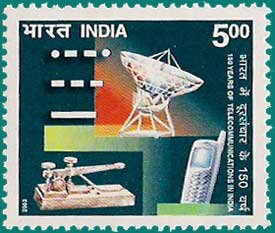150th Anniversary of Telecommunications

Technical Data
| Date of Issue | November 1, 2003 |
|---|---|
| Denomination | Rs. 5 |
| Quantity | 800,000 |
| Perforation | comb 13½ x 13 |
| Printer | Eagle Press Ltd. |
| Watermark | No Watermark |
| Colors | Multicolor |
| Catalog Codes |
Michel IN 1990 Stamp Number IN 2030 Yvert et Tellier IN 1755 Stanley Gibbons IN 2164 WADP Numbering System - WNS IN047.03 |
| Themes | Anniversaries and Jubilees | Satellite Dishes | Telecommunication | Telegraphy | Telephones | Telephony |
Table of Contents
Commemorative Stamp Set: Telecommunications in India
Design Elements
- Historical Timeline: The stamps depict key milestones in the development of telecommunications in India, from the early electric telegraph to modern cellular services.
Imagery:
- First Stamp: Features a vintage telegraph machine and a historical map showing the first connections between major cities like Calcutta and Peshawar.
- Second Stamp: Illustrates early telephone exchanges and the first automatic exchange at Shimla, showcasing old-fashioned switchboards and early telephone technology.
- Third Stamp: Highlights advancements such as radio telegraphy, radio telephony, and trunk lines used for broadcasting, with imagery of radio towers and broadcast equipment.
- Fourth Stamp: Showcases modern cellular services with images of cell towers and mobile phones, reflecting the growth and technological advancements of the telecom sector.
- Color Palette: The design uses a blend of historical sepia tones for early technology and vibrant colors for modern elements to represent the evolution of the field.
Cultural and Historical Significance
- Telegraph and Telephone Innovations: Marks the journey from the first telegraph lines to the development of telephone exchanges and modern cellular networks, which transformed communication across India.
- Pioneers and Milestones: Acknowledges the contributions of key figures like Dr. William O’Shaughnessy and important developments in telecommunications, such as the establishment of the first automatic exchange and the introduction of cellular services.
- National Integration: Highlights how telecommunications have played a crucial role in connecting diverse regions and facilitating national integration.
Usage
- Commemorative Purpose: Ideal for collectors and enthusiasts of Indian history and technology.
- Educational Tool: Can be used in educational settings to illustrate the evolution of technology and its impact on society.
- Public Celebrations: Suitable for use in events celebrating the achievements of India’s telecommunications sector and its contribution to national development.
Importance of the Commemorative Stamp Set
- Historical Reflection: Provides a visual representation of the significant progress in telecommunications over the years, reflecting the sector’s impact on Indian society and its development.
- Educational Value: Serves as a resource for learning about the history and advancements in telecommunications, promoting awareness of this essential sector.
- Cultural Heritage: Celebrates the legacy of innovation and technological progress that has shaped modern India.
Example of the Stamp Design
- First Stamp: Features a historical telegraph machine with a background of early telegraph lines connecting major Indian cities.
- Second Stamp: Depicts an early telephone exchange with switchboards and operators, representing the growth of telephone technology.
- Third Stamp: Illustrates a vintage radio telegraph station and broadcast equipment, highlighting early communication advancements.
- Fourth Stamp: Shows modern cell towers and mobile phones, symbolizing the advancement to cellular communication and the current state of the telecom industry.
Significance
The Telecommunications in India commemorative stamp set celebrates the remarkable journey of technological advancements in communication. From the initial telegraph lines to the advent of cellular services, this set acknowledges the significant milestones and innovations that have shaped India’s connectivity and communication landscape.
